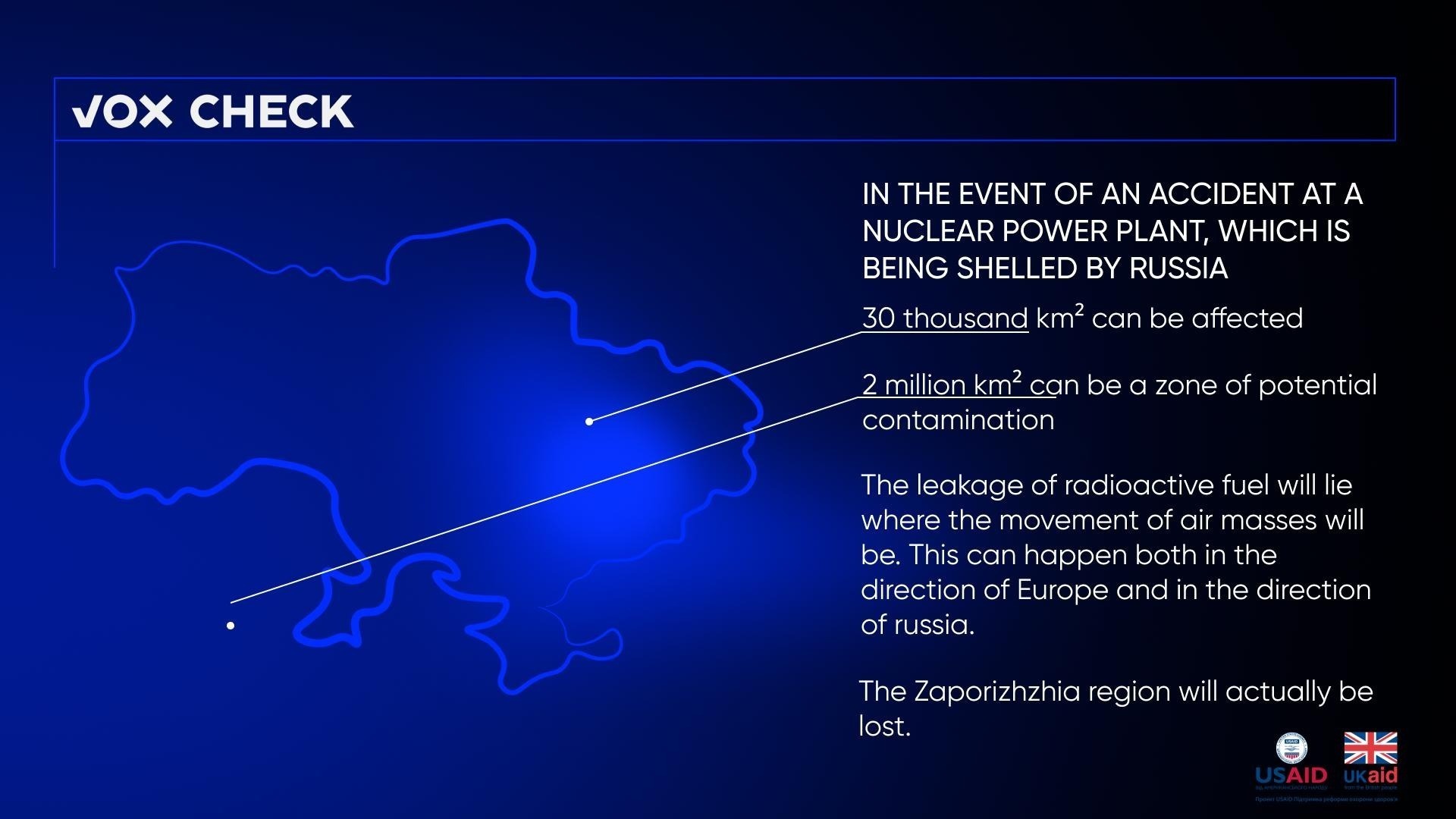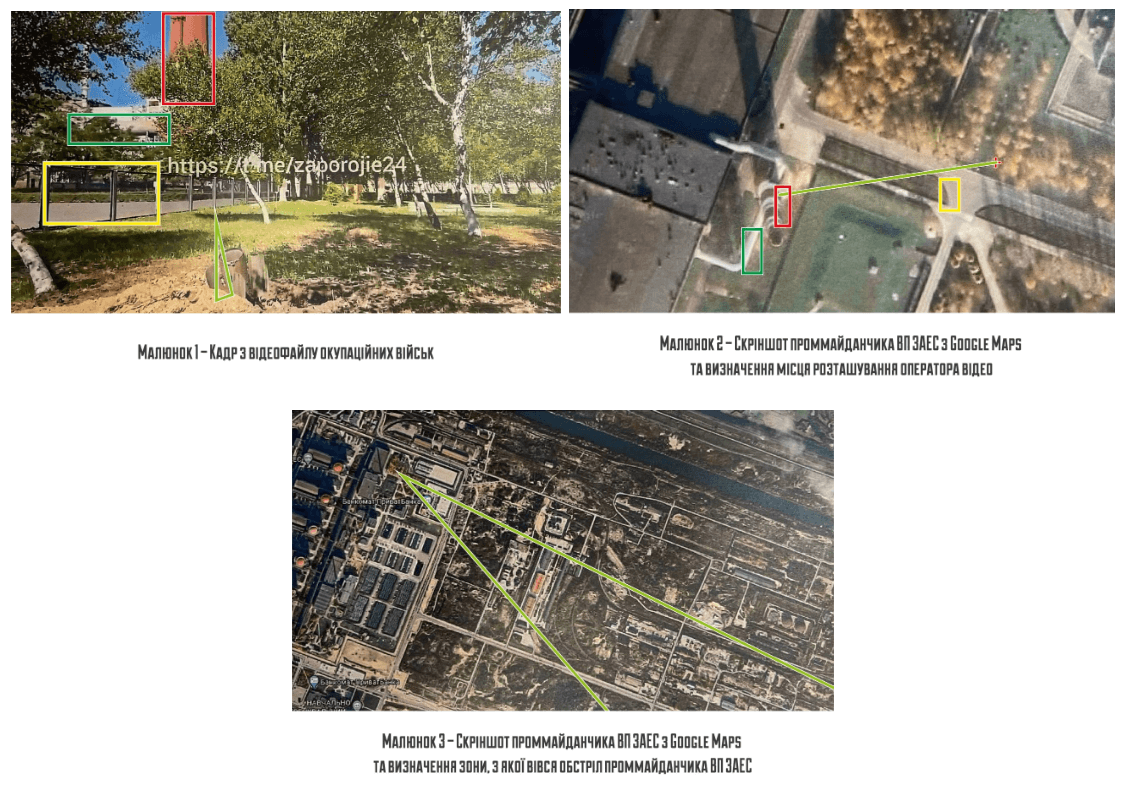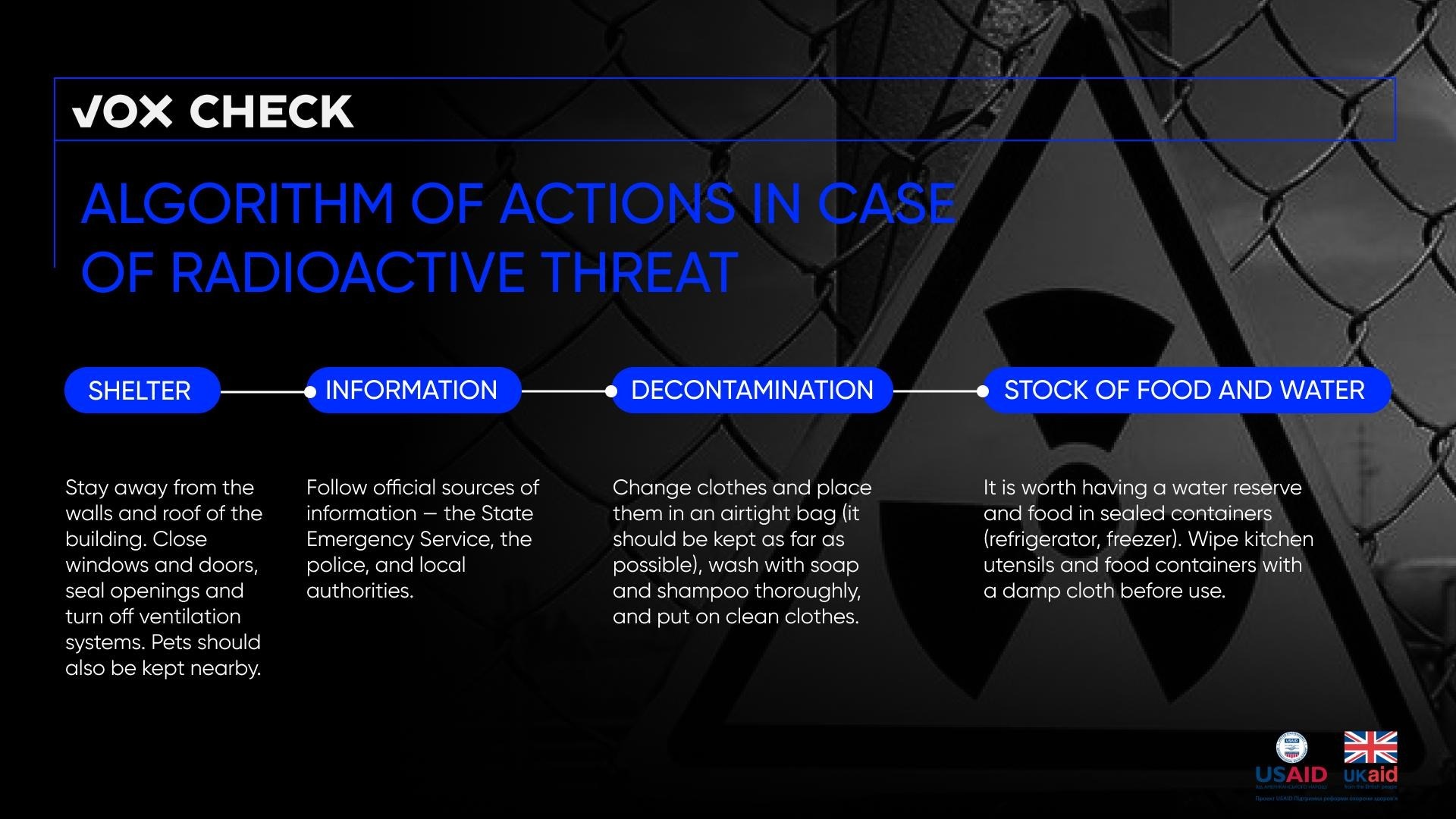On August 25, 2022, for the first time in history, the Zaporizhzhia nuclear power plant stopped. Only late in the evening will the IAEA report that the connection with the power system has been restored, but the power units remain disconnected. The reason for the potential disaster is the systematic shelling of the nuclear power plant by the occupiers. President Volodymyr Zelenskyi will say this in his evening address to Ukrainians: “Russia has put Ukraine and all Europeans one step away from a radiation disaster.”
At the beginning of March, кussian troops opened fire on the Zaporizhzhшa NPP, and since then, the NPP has come under the control of the russian occupiers. During this time, the invaders finally gained a foothold at the station and turned the nuclear facility into a fortification.
For russia, it is a tool of provocations and blackmail both on the Ukrainian side and the whole world. That is why hundreds of fakes and manipulations surround the situation at the ZNPP. The russians are desperately trying to justify acts of terrorism and shift the blame to Ukraine. However, during the six months of the war, russia repeatedly changed its rhetoric regarding the situation at the station. How exactly — we will tell you further.
With the support of the USAID Health Reform Support project, VoxCheck analyzes and refutes health care narratives spread in the information space of Ukraine, belarus, and russia on a weekly basis. Read previous issues here.
March. Russia claims that it is not shelling the ZNPP, but on the contrary, it is “protecting” it from provocations by Ukraine
The Zaporizhzhia NPP has been under occupation since the beginning of spring. On russian channels, the seizure of a nuclear facility and the holding of workers in captivity were called “protection.” Because of “good intentions,” on March 4, the occupiers started aiming at nuclear blocks from tanks equipped with thermal imaging cameras. As a result, one of the power units was damaged, and a fire broke out in the training building of the NPP. During the battles for the station, the russian Telegram channel “Svodki opolcheniya Novorossii Z.O.V. (Сводки ополчения Новороссии Z.O.V.)” wrote that although a projectile hit the first power unit (whose projectile was not specified), it “doesn’t smell like Chornobyl 2.“
In fact, as the head of the security analysis department of the State Scientific and Technical Center for Nuclear and Radiation Safety, Dmytro Humeniuk explained, the ZNPP was designed back in the 70s, and therefore there are no protective systems against shelling.
In the days of the fiercest confrontations, the russian media tried not to specify who was responsible for shelling the largest nuclear power plant in Europe. Only general phrases were used: “there was an ignition”, “a rocket hit“. Moreover, russian “experts” convinced: everything is under control.
By the morning of March 4, propagandists had already invented the cause of the fire at the ZNPP. The occupiers accused the “Ukrainian subversive intelligence groups” of setting fire to the administration building. In two days, a new version of the events will be announced: allegedly, records, which refer to the development of nuclear weapons, were stored at the facility.
Russia will return to this version already in April. And so far, the russian mass media have been convincing: this is not the occupation of a nuclear facility of an independent state, but “protection” and “help”. Probably, the fact that on March 14, the occupiers blew up part of the ammunition at the site of the power plant was also a “help” of the russian federation. As a result of the explosions, the building of the Zaporizhzhia NPP Training Center was severely damaged. The pro-kremlin publication TASS tried to present the news in the style of “that’s what we planned.” And it noted that the military carried out the disposal of surviving ammunition, the level of radiation remained normal, and there was no threat to life.
However, even the very fact of capturing the station already contradicts one of the seven integral components of nuclear safety: personnel must be able to perform their duties and make decisions without undue pressure. The russian occupiers brazenly violated observance of this point. According to the State Atomic Energy Regulatory Commission, the station’s employees were forced to work under constant psychological pressure from russian military personnel. Food and medicine shortages were also reported. All these factors increase the risk of personnel making mistakes that could lead to an accident.
Consequences of the accident at the ZNPP
April-May. Russia focuses on the fact that Kyiv allegedly planned to create nuclear weapons at the ZNPP
The myth of the nuclear bomb appeared even before the full-scale invasion of russia. After President Volodymyr Zelenskyi’s speech at the Munich Security Conference on February 19, the kremlin-controlled media accused Ukraine of restoring its nuclear arsenal.
It is not true. The last strategic nuclear weapons were removed from Ukraine in June 1996. Zelenskyi’s statement about the Budapest memorandum did not mention the restoration of nuclear status. He only emphasized that he was calling for consultations of guarantor states “for the fourth and last time”. But if they do not take place, then “Ukraine will consider that the document does not work“. At the same time, the rejection of the Budapest Memorandum does not exempt Kyiv from its obligations under the Treaty on the Non-Proliferation of Nuclear Weapons. According to it, non-nuclear states undertake not to produce nuclear weapons.
So, the narrative about nuclear weapons was launched even before a full-scale war and was updated already in March (we wrote about this above). Therefore, now russia only has to spin this case. Throughout April, propagandists crystallized a fake justification for occupying the station: “if the Nazis take over the ZNPP, there will definitely be an explosion.”
The propagandists did not abandon this idea even in May. On May 26, the russian media began to write en masse that nuclear materials that could be used for the development of weapons are stored at the ZNNP. After all, the director of the IAEA, Rafael Grossi, told the World Economic Forum in Davos that the power plant stores 30 tons of plutonium and 40 tons of enriched uranium, which may not be used for their intended purpose.
However, this information is completely false. The facility has only spent heat-separating assemblies — nuclear fuel that cannot be used for military purposes, Energoatom noted. Such elements are present at all nuclear power plants in the world.
The chief state inspector for nuclear and radiation safety Oleh Korikov wrote an open appeal to the IAEA in which he explained that Ukraine could not produce or store even a few grams of weapons-grade plutonium or uranium as there are no appropriate technologies for this. In addition, the organization submitted a report every year and confirmed that the Ukrainian authorities were complying with their obligations regarding the exclusively peaceful use of nuclear material. Ukraine disposed of all highly enriched uranium in compliance with the 2010 Communiqué of the Washington Summit on Physical Nuclear Security.
In this way, Rafael Grossi shares russia’s fake theses. Such statements do not contribute to the de-escalation of the situation but, on the contrary, increase the sense of impunity of the occupiers, Korikov noted.
May. Russia demands from Ukraine to pay for electricity from the ZNNP
On May 18, Deputy Prime Minister of the russian federation, Marat Khusnullin, announced that the ZNNP would work for russia, and Ukraine would have to pay for the export of electricity, or it would be turned off.
In fact, as Energoatom explained, it is technically impossible to do this: the Ukrainian network is disconnected from russia and belarus. The Ukrainian regulator controls the nuclear power plant, and attempting to change the situation will be considered an act of nuclear terrorism.
May-June. Russia claims that Ukraine is allegedly blocking the visit of the IAEA mission so that the world “does not learn the truth”
At the end of May, russian officials planned to send an IAEA security mission to the station. On June 6, the director of the organization, Rafael Grossi, announced that he would soon visit the ZNPP at the invitation of Ukraine.
We’re working to send an expert mission to #Zaporizhzhya Nuclear Power Plant. The biggest NPP in Europe is currently disconnected from @IAEAorg safeguards communications systems. #Ukraine requested us, we will go there. pic.twitter.com/gFiBN2LdBq
— Rafael MarianoGrossi (@rafaelmgrossi) June 6, 2022
But the arrival of the delegation at the station captured by the russians would mean approval of the occupation. Energoatom has previously refused the IAEA, indicating that any visits are possible only after the plant is freed. The arrival of experts through russia or the occupied territories, without the consent and invitation of the Ukrainian side, is interference in international politics on the side of the aggressor. In addition, Ukraine will not be able to provide any security guarantees for the delegation as long as foreign troops are stationed at the station.
In response to this, the propagandists stated that Kyiv misinformed the international community all the time. According to the ex-head of the russian Minatom, everything is calm at the station, the employees perform their duties, and the system works stably, so Bankova is afraid of the arrival of an independent mission. We explained why this is not true in the previous chapters.
Context
At the beginning of August, Kyiv changed its decision regarding the IAEA’s visit to the station. Ukraine called on the UN and the IAEA to send a security mission to the ZNPP, but with the condition that the delegation should come only from the territory controlled by Ukraine. This is the “principled position” of the government, emphasized the Minister of Foreign Affairs Dmytro Kuleba.
The heads of both structures agreed to visit the station. However, UN spokesman Stephane Dujarric said that the delegation would come to the ZNPP only with the consent of both states — Ukraine and russia. The kremlin demanded that the delegation’s route not pass through Kyiv.
July. Now russia directly says: “The Armed Forces of Ukraine are shelling the power plant”
Do you remember how the russians started preparing the base back in the spring to shift the blame for the shelling of the ZNPP to Ukraine? It’s time to spin that narrative! On July 12, RIA Novosti reported that Ukraine was shelling Enerhodar directly next to the ZNPP. And the so-called “member of the main council of the military-civilian administration” of Zaporizhzhia, Volodymyr Rogov, said that the Ukrainian command planned to strike the reactor cooling system. They said that this is how Kyiv seeks to provoke a tragedy similar to Chornobyl.
In fact, the occupiers tried to sow panic among the civilian population and provoke a mass exodus from the city. A huge traffic jam at the exit from Enerhodar could have stopped the counteroffensive of the Armed Forces of Ukraine. Probably the invaders wanted to use people as human shields.
On July 20, russian media reported that the Armed Forces of Ukraine had struck a nuclear power plant, injuring 11 workers.
And again, a mistake (of russian propaganda, of course!). In fact, as explained in the press service of the Defence Intelligence of the Ministry of Defence of Ukraine, the military destroyed the tent city of the occupiers near the ZNPP. As a result of the attack, 3 soldiers of the russian federation were killed, and 12 were wounded. Bellingcat reporter Wim Zwijnenburg published satellite images that confirm that the strike was carried out on the tents of the russian military.
There was one Ukrainian confirmed strike using a Polish WARMATE loitering munitions/kamikaze drone against some tents with Russian military personnel mid-July 2022. 7/x https://t.co/fR58HkNizz pic.twitter.com/whBfainbEd
— Wim Zwijnenburg (@wammezz) August 8, 2022
The first half of August. Russia is finally confused about what is happening at the ZNPP and accuses Ukraine of nuclear terrorism
As a result of a series of russian attacks on August 5, 6, and 7, the 4th power unit was disconnected from the power system and transferred to the reserve, the nitrogen-oxygen station and the combined auxiliary building were damaged. In addition, the projectile hit three radiation monitoring sensors around the station. The russian media sounded the alarm: Ukraine is blackmailing the world with a nuclear threat. The Ministry of Foreign Affairs of the russian federation called on representatives of the UN and the IAEA to intervene in the situation and “influence the Kyiv regime.”
On August 9, the pro-russian ZeRada Telegram channel wrote at 00:15 that Ukraine is ready to accept a peacekeeping mission at the ZNPP. The authors fully approved such a decision and noted that it does not matter at all who will be part of the delegation: India, the People’s Republic of China, or Turkey. After all, the main thing is the nuclear safety of the world! However, after a few hours, it turned out that the russians were not satisfied with all delegations to the ZNPP. Thus, the Politjudo (Политдзюдо) telegram channel admits that the presence of NATO representatives will prevent the occupying army from “advancing in the Zaporizhzhia region.” Russia even initiated a meeting of the Security Council regarding the situation at the Zaporizhia NPP. Kremlin officials tried to blame Ukraine for the shelling.
What really happened? The propagandists did not achieve the desired effect. On the contrary: the EU and 42 other countries emphasized that the presence of russian troops and weapons on the territory of the ZNPP is unacceptable and violates the principles of security and guarantees that all IAEA members have pledged to respect. In a joint statement, the countries called on the russian federation to immediately withdraw its troops and personnel from the territory of the ZNPP so that Ukrainian personnel could continue to perform their duties.
On August 8, the RIA Novosti publication published an article in which it is alleged that the occupying authorities have named the places from where Ukraine is shelling the ZNPP. Collaborator Yevhen Balytskyi, appointed by the occupiers as the “head of the administration of the Zaporizhzhia region,” said that the Armed Forces of Ukraine were shelling the Zaporizhzhia NPP from Marganets and Nikopol. The so-called Enerhodar authorities also reported that on the night of August 6-7, the Ukrainian military allegedly struck the ZNPP with an Uragan surface-to-air missile, and shrapnel and a rocket engine fell about 400 meters from the plant’s operating power unit.
In fact, these shellings were carried out by the troops of the russian federation. On August 11, Energoatom published an analysis of a video from propaganda telegram channels, which proves that on August 6, the attack on the ZNPP was conducted by russian troops, approximately from the industrial zone located between the nuclear plant and Enerhodar.
1st photo: the angle of inclination and the place of landing of the projectile. 2nd photo: the flight path and the location from where the operator fired the projectile. The 3rd photo: the zone from which the occupiers fired at the industrial site of the ZNPP
As a result of a series of attacks on the station on August 11, the occupiers damaged several radiation sensors and the pumping station. After the shelling on August 5-7, three communication lines had to be disconnected, transferring all the power to one line is dangerous for the station itself. All actions were planned and played into the hands of the occupiers. On August 12, the telegram channel “Svodki opolchenia Novorossii Z.O.V. (Сводки ополчения Новороссии Z.O.V.)” reported that due to constant shelling by the Armed Forces of Ukraine, the level of electricity has significantly decreased, so the NPP will soon have to be “conserved”, and the southern regions of Ukraine will remain without electricity.
The threat of stopping the operation of the ZNPP is nothing more than another nuclear blackmail and the implementation of the plan to connect the ZNPP to the power system of the russian federation. On August 13, a ZNPP engineer said in an interview with the BBC on condition of anonymity that the russian army had placed on the territory of the station MLRS, other military weapons, and equipment. According to the engineer, the russian federation is targeting high-voltage lines in order to destroy the connection between the ZNPP and the energy system of Ukraine. In the event of a breakdown of high-voltage transmission lines, the cooling of nuclear reactors will stop. This may have the following consequences: either russia will switch the ZNPP to its own power system, or a nuclear disaster will occur.
What to do in case of a nuclear disaster?
The second half of August. Russia is trying to prove that its weapons and equipment are not at the nuclear power plant, and Ukraine is preparing new provocations
The Ministry of Defense of the russian federation claimed that they could provide the IAEA with satellite images with a “strong” resolution in order to “debunk the lies of the Kyiv regime.” However, the department did not specify the exact date and time when the photos would be published.
Instead, on August 19, Canadian intelligence reported that the occupiers had placed military equipment inside the station, particularly near the reactor housings and other key infrastructure. On the same day, a CNN video appeared online showing russian military equipment in the engine room of the ZNPP. The video shows at least five cars, one of which can be seen with a “Z” mark. CNN employees asked the Ministry of Defense of the russian federation for a comment with a request to answer what is inside and around the military equipment at the ZNPP, but the media did not receive a response.
Screenshots from the video
On August 18, President of Turkey Recep Tayyip Erdogan and UN Secretary-General Antonio Guterres arrived in Kyiv. Erdogan and Zelenskyi discussed the situation around the Zaporizhzhia NPP and russia’s nuclear extortion. Russian media described it, allegedly the leaders came to Ukraine to persuade Zelenskyi to compromise and stop shelling the ZNPP. And according to the Ministry of Defense of the russian federation, immediately after the arrival of Antonio Guterres, the Armed Forces of Ukraine planned a provocation at the ZNPP in order to then accuse russia of creating a man-made disaster.
The occupiers use the “informational alibi” technique. By reporting the shelling ahead of time, they absolve themselves of responsibility. For example, on August 3, Igor Vyshnevetskyi reported on “the risk of provocations at Ukraine’s nuclear facilities by nationalist groups.” Two days later, the ZNPP was shelled twice.
Now, by “prophesying” further provocations by the Ukrainian subversive intelligence group, the russians are again trying to avoid responsibility. At the same time, the Defence Intelligence of the Ministry of Defense of Ukraine reports that the latest events at the ZNPP indicate preparations for disconnecting the plant from the Ukrainian power grid. Yes, the occupiers ordered the station employees to stay at home, instead, they returned part of the representatives of Rosatom. In addition, the russians did not specify how long the “weekend” would last.
In conclusion
During the six months of occupation, the russians created a whole ecosystem of lies around the topic of the ZNPP. Fake messages were spread both by little-known Telegram channels and by state media. There was so much misinformation that it “reached” even international officials (as in the case of Rafael Grossi’s statements about plutonium and enriched uranium). Over time, the constant repetition of the same narratives and the layering of new ones convinced “ordinary russians” that the kremlin simply had no choice but to “protect ZNPP from the Nazis.”
In fact, any discussion here is superfluous: moscow should withdraw its troops from the territory of the ZNPP, EU representatives emphasized on April 26. In August, the European Union’s High Representative for Foreign Policy, Josep Borrell, wrote that russia should immediately return complete control of the ZNPP. On August 14, representatives of the EU and 42 countries declared that the russian military should leave the station’s territory. However, the kremlin stubbornly ignores these calls. After all, russia has not yet sufficiently “protected” the ZNPP, or maybe it simply hasn’t had time to reconnect the plant to Crimea?
Disclaimer: This information piece was produced with the assistance of the United States Agency for International Development (USAID), provided on behalf of the people of the United States of America, and with the support of the United Kingdom Government’s Good Governance Fund program on behalf of the people of Great Britain. This article’s content is the sole responsibility of Deloitte Consulting under contract #72012118C00001. It does not necessarily reflect the views of USAID, the United States Government, UK aid, or the United Kingdom Government.
Attention
The authors do not work for, consult to, own shares in or receive funding from any company or organization that would benefit from this article, and have no relevant affiliations








